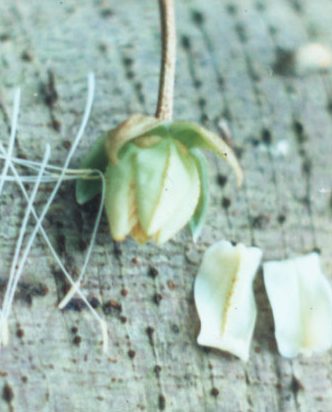Capparidaceae CAMARON BLANCO
Tree: Occasional evergreen treelet or shrub (2-5 m) found in the shady lower layers of the humid tropical forest. An inconspicuous, unobtrusive plant, Camaron Blanco is usually first recognized when it bears the bright orange seed pods that are a hallmark of the Capparis genus.
Description: Usually straight, the trunk or stem (4 cm) of this species gives rise to a small number of leggy branches. These extend horizontally and give the treelet a thin, frail aspect. Stem and branch bark is brown, but the twigs are tan-colored and reflect light with a metallic, lustrous sheen. In addition, these twigs are ridged, flattened, and dotted by reddish point lenticels. Leaves (16 cm by 5 cm) are simple and alternately arranged. Almost perfectly elliptical in shape, they end in slowly tapering drip-tips. Inferior leaf surfaces share the tan color and unusual lustrous sheen of the twigs, as do the ridged flower buds. Flowers are large (3 cm), with four triangular sepals (green inside, tan outside); four creased, white petals; numerous (about fifty) long stamens (3 cm); and one, very long (8 cm) central stalk supporting a hot-dog-shaped pistil at its distal end. A nectar ring encircles the base of the blossom. Flowers are generated from small axillary racemes and appear over an extended period of time in very small numbers. The months of September through November see the most blossoms and the highest degree of synchronization between trees, though sporadic flowers have been observed at almost all times of the year. When the flowers die – they are exceedingly delicate and last intact for only a few hours – the petals, sepals, and stamens fall away, leaving only the thickened, disk-like pedestal behind.
The rod-shaped pistil – at the end of its long stalk – grows slowly into the fruit: a narrow, reddish-brown cylindrical pod that measures 30 cm in length and 1 cm in diameter. Bean-shaped, this pod has visible constrictions between the 20 or so seeds that it contains. After reaching full size, the pods remain dormant, dangling from the ends of the branches for nearly a year before maturing. When finally ripe, they slowly begin to split longitudinally, opening from the lower, distal end upwards over the course of about two weeks. As this process proceeds, the outer wall of the pod turns inside out, revealing the striking, fluorescent orange color of the inner tissue. Small, black seeds (0.5 cm) are also exposed, embedded in this orange lining. Harvests last from November through the middle of January (occurring a year or more after the corresponding flowers were pollinated).
Similar Species: In Manuel Antonio, there are no other small treelets that possess the coppery metallic luster seen on twigs, buds, and leaf surfaces. When fruits are visible, these structures are unique and identifying. In Guanacaste, C. cynophallophora is replaced by C. indica – a similarly sized tree that also sports orange-lined seed pods.
Natural History: The location of the pistil in the Capparis flower, far away from the petals and the stamens, may be this species’ way of avoiding self-pollination. Pollen is less likely reach the stigma of the same blossom when the anthers are not close by. As a means to this same end, other species make tiny pistils and tuck them deep within the flower corolla. Their stamens protrude into the air, well away from the protected stigma. Still other plants make use of temporal isolation, causing anthers and ovules mature at different times.
Pollinators (bees and other insects) are attracted to the flesh-colored ring of nectar found encircling the base of the Capparis flower. Seed dispersers are almost certainly birds, drawn to the bright orange linings of the pod’s inner walls. Such vivid colors in fruits are usually a signal to color-sighted animals (mostly primates, birds, and insects) that something edible is present. However, in this case it appears that Capparis relies on the appearance of food to trick animals into dispersing its seeds. No arils surround them and the pods themselves are leathery and inedible. Perhaps curious and hungry birds (or monkeys), lured to the fruits by their enticing color, occasionally test them for their food value and, in so doing, carry their seeds a short distance. If this occurs – even only occasionally – the plant may successfully disperse enough seeds to ensure its survival while saving the energy necessary to produce nutritious food.
Uses: The Capparidaceae family is the source of capers, which are actually the flower buds of various Capparis species.
Distribution: In Costa Rica, Camaron Blanco is confined to the humid forests of the central and southwestern Pacific coast (Zamora, 1989).
Images: Leaf Flower Bud Flower Fruit



